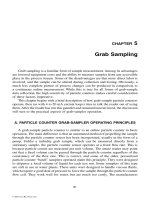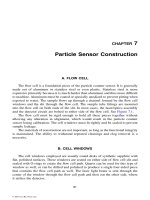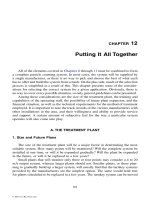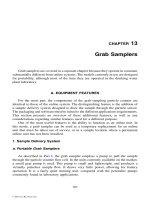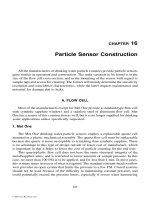GIS for Coastal Zone Management - Chapter 14 potx
Bạn đang xem bản rút gọn của tài liệu. Xem và tải ngay bản đầy đủ của tài liệu tại đây (211.62 KB, 13 trang )
CHAPTER FOURTEEN
GIS Applications In Coastal Management:
A View from the Developing World
Peter C. Nwilo
14.1 INTRODUCTION
Geographic Information Systems have revolutionised the way spatial
data/information is acquired, stored, managed, and displayed. In the past the
acquisition of spatial data was done mainly with analogue theodolite and levels,
and the recording and storage of these data were done in analogue manner. Data
management was a very cumbersome exercise and the display was in the form of
paper maps. Recent developments in information and digital technologies,
communication and satellite technology, and improved computing speed and
computer hard disk space, have impacted tremendously the way spatial data is
acquired, stored, managed, and displayed. The development has created a
revolution in spatial information technology in a way never experienced before.
Today, virtually every human activity is spatial. Some schools of thought stipulate
that in countries such as the United States and the United Kingdom as much as 75-
80% of all the activities is spatial. There is correlation between geospatial
information technology development and economic development. Developed
countries of the world are associated with high spatial information technology
development. Conversely, poor economic development is associated with low
spatial information technology development as witnessed in developing countries
of the world.
The development of Geographic Information Systems and associated
technologies has created and is still creating employment opportunities all over the
world. It has also led to changes of curricula of training institutions, and new
training opportunities are being created. Transfer, sharing access to and
development of spatial data standards have become major issues. We now discuss
spatial data infrastructure as a major requirement for development, as has long
been done with regards to other infrastructures such as roads, rail and waterways,
electricity, and water supplies.
Geographic information has been employed in several fields such as
management of disasters, vehicle tracking systems, forestry, utilities management,
oil exploration, environmental management, health management, census, and
© 2005 by CRC Press LLC
mineral resources development, governance (EIS Africa, 2002) and – the focus of
this paper – coastal management.
14.1.1 Coastal Areas
The coast is an area that witnesses a substantial amount of physical and economic
activities. It is a zone of great significance in the sense that intense agriculture,
business and recreational activities take place here. Settlements have been
established in these areas and international trade and communication originated in
the coastal fringes (Nwilo, 1995; Nwilo
et al., 1995). The coastal zone houses
about two thirds of the world’s population and this percentage is expected to
increase to 75% by the year 2020 (UNEP, 1992; Hanson & Lindh, 1993). Most of
the important cities of the world, such as Alexandria, Lagos, London, Rotterdam,
Shanghai, Tokyo and Venice, are located within the coastal environment, while
two thirds of the world’s cities having a population of over 2.5 million are within
the coastal zone (Borrego, 1994). The coastal environment is very rich in both
living and non-living resources. For example, a lot of crude oil and gas
exploration and exploitation take place with the coast.
Wetlands are known to be a very productive ecosystem. Most of these
wetlands are located in the coastal areas. They are the sanctuaries to many global
endangered species and also can assist in dampening the effect of flooding from
normal sea flooding, storm surges and sea level rise. Fishes that are caught in the
upwelling zone of the Canary Island coast are hatched within the mangrove
ecosystem of the Niger Delta and later migrate to the upwelling area. Similar
relationships are found in most of the world’s major fishing waters.
The coast is therefore a very important zone. Having discussed the
importance of the coastal areas, it is now necessary to define the ‘coastal zone.’
Bird (1967; 1985 & 1993) defines the coast as a zone of varying width including
the shore and extending the crest of cliff, the head of a tidal estuary, or the solid
ground that lies behind the coastal lagoon, dunes and swamps. Komar (1976) on
the other hand defines the coastal zone to include the littoral zone and extending
further inland to include the sea cliffs, any marine terraces, dune fields and so on;
the seaward limit is limitless. For most studies the coastal zone refers to that zone
that is affected by what happens on the sea and on land. The coast is therefore
very important for the existence of human life.
14.1.2 Integrated Coastal Area Management
Integrated Coastal Areas Management is defined as a dynamic process in which a
coordinated strategy is developed and implemented for the allocation of
environmental, socio-cultural and institutional resources to achieve the
conservation and sustainable use of the coastal area (Coastal Area Management
and Planning Network, 1989; Nwilo, 1995). Planning for sustainable resource
management is based on weighing priorities, translating these priorities into
policies and finally defining goals, identifying responsibilities for each step and
establishing a time frame for action and review (Nwilo, 1995). There is no one
© 2005 by CRC Press LLC
‘right’ way to manage coastal areas. However the design of a coastal management
programme or policy for a nation or a region should take into consideration the
legal instrument for the implementation of the program as well as the instrumental
frame work for policy implementation (Emovon, 1991).
In order to practice effective coastal management, planners need to
understand the way the natural environment and human activities are
interconnected to form a system. Key aspects of the system include the following
information themes:
i.
Biological: This includes type and extent of ecosystem, primary
productivity, specie diversity and abundance, nursery grounds and
life cycles;
ii. Physical: This includes topography, geology, temperature, salinity,
nutrients, tides, sea level and current, meteorology, sediment types
and distribution, flooding and erosion/ accretion;
iii. Socio-economic: This includes human population distribution and
growth, economic activities and land use;
iv. Legal and Institutional: Land tenure system, resource use rights,
relevant laws and regulations, responsible agencies and availability of
financial and human resources (Borrego, 1994).
Each of these activities is greatly influenced by activities within and beyond
the coastal zone. It is for this reason that the resolution of conflicts in the use of
coastal resources requires a broad perspective on the environmental process and
interaction among human activities.
14.2 THE GUINEA CURRENT LARGE MARINE ECOSYSTEM PROJECT
14.2.1 The Concept of Large Marine Ecosystem Project
Large Marine Ecosystems are regions of the ocean space encompassing coastal
areas from river basins and estuaries to the seaward boundaries of the continental
shelves, and the outer margins of the world’s current system. These marine
regions are considered in terms of their ecological unity based on their distributive
bathymetry, hydrographic, productivity, and trophic linkages (Sherman
et al.,
1993; UNIDO, 2002). The world’s 64 LMEs are the most productive ecosystems,
and together produce 95% of marine fishery biomass yields. It is also in the LMEs
that most of the global ocean pollution, fisheries over-exploitation and coastal
habitat alteration take place.
The LME ocean management approach focuses on the sustainable
development of the ocean resources and requires a paradigm shift from a small
spatial scale to a larger one and from a short-term to a long-term perspective. It
requires countries bordering the LME to set priorities on how to tackle their
common transboundary issues. Since the early 1990s, the developing countries
have approached the Global Environment Facility (GEF), the United Nations
Industrial Development Organisation (UNIDO) and other United Nation
implementing agencies for technical and scientific assistance in restoring and
© 2005 by CRC Press LLC
protecting their coastal and marine ecosystem. GEF agreed to provide guidance
and funding in addressing these issues within the framework of sustainable
development. It recommended the use of the Large Marine Ecosystem (LME)
concept and their contributing freshwater basins as the geographic focus for
addressing the issues (UNIDO, 2002).
14.2.2 The Guinea Current Large Marine Ecosystem Project Implementation
The Guinea Current Large Marine Ecosystem Project is funded by the Global
Environment Facility (GEF) and managed by the United Nations Industrial
Development Organisation (UNIDO). The phase I of this project was started in
1995 and ended in 1999 with the countries of Cameroon, Nigeria, Benin Republic,
Togo, Ghana and Côte d’Ivoire participating. Apart from GEF and UNIDO, some
form of scientific and technical support came from the United Nations Education
and Scientific Cultural Organisation (UNESCO), other UN agencies, and the US
National Oceanic and Atmospheric Administration (NOAA). The participating
countries provided in country support in the form of logistics such as provision of
offices and transportation vehicles. The execution of the project was in form of
modules. The modules that were covered in the project included Integrated
Coastal Areas Management (ICAM), Geographic Information System (GIS),
Mangroves, Industrial Pollution, Policy Issues, Fisheries, Coastal Erosion,
Plankton and other pollution. The structure made provision for a National Project
Director in each of the participating countries and a National Expert for each of the
modules. All the national experts were reporting to an International Expert who
co-ordinated each of the modules. The project had a Project Coordinator who was
based in Abidjan, Côte d’Ivoire. The office of the Project Coordinator also served
as the Secretariat for the project. In each of the participating countries, there was a
Focal Point Agency and Focal Point Institution.
In Nigeria, the now-defunct Federal Environmental Protection Agency was
the focal point agency, while the Nigerian Institute for Oceanography and Marine
Research was the focal point institution. There were other participating
institutions such as the University of Lagos. In the other participating countries,
the focal point agency was the Ministry of Environment. Efforts were made in the
project to collaborate with relevant institutions.
The second phase of the project is bringing in an additional 10 countries.
These include Guinea Bissau, Guinea, Sierra Leone, Liberia, Congo Brazzaville,
Democratic Republic of Congo and Angola. These countries, in addition to the
original six, are in partnership activities for sustainable development of the Guinea
Current Large Marine Ecosystem (GCLME). The addition of these to the original
six countries meant that the full extent of the Gulf of Guinea Current Large Marine
Ecosystem is covered. This stage of the project will commence in January 2004
(UNIDO, 2002).
All participating countries are making contributions to a Transboundary Diagnosis
Programme (TAD) and a Strategic Action Programme (SAP) for the project
(UNIDO, 2002).
© 2005 by CRC Press LLC
14.2.3 The ICAM Module
The essence of the Guinea Current Large Marine Ecosystem project is the
sustainable management of the living resources of the Gulf of Guinea region. The
region was experiencing a serious environmental stress due to urbanisation,
pollution from industries and domestic wastes, population explosion, oil spillage,
deforestation, erosion, and over-fishing. The fish stocks were depleting at a fast
rate and the socio-economic lives of the inhabitants are adversely affected. The
lagoons that dot the coast from Côte d’Ivoire to Nigeria had become heavily
polluted. Most of the problems highlighted above are transboundary in nature.
There was therefore a need to reverse the situation and address these problems
from a regional perspective rather than from a national perspective.
Under the module, an experienced ICAM professional prepared guidelines
for implementation of ICAM in the countries. The National Experts prepared a
country profile for each of the six participating countries in the first phase. The
country profile is a baseline of the situation in each of the participating country’s
coastal area. The information used in preparing the country profile was obtained
from existing literature and from relevant institutions. This was followed by a
three-day workshop where stakeholders discussed the profile and made
recommendations where necessary. A final copy of the country profile was made
after effecting the necessary corrections from stakeholders.
An outcome of the workshop was the setting of the National Integrated
Coastal Area Committee for each of the participating countries. Another success
of the workshop and activities of the Guinea Current LME phase 1 is the creation
of awareness on the importance of Integrated Coastal Area Management: prior to
the Guinea Current LME project, there was no National ICAM Committee in any
of the six participating countries.
As part of the efforts to assess the health of the Guinea Current LME, a fish
trawl survey was carried out from Côte d'Ivoire to Cameroon. Results from the
survey confirmed the fear that the fish stock, together with the plankton, was being
depleted.
Figure 14.1 shows the Gulf of Guinea Region while Figure 14.2 shows the
countries that took part in the first phase of the project
© 2005 by CRC Press LLC
Figure 14.1 The Guinea Current Region
Figure 14.2 Countries that participated in the GCLME Project, Phase I
14.2.4 Application of GIS to The Project
As was the case in the Integrated Coastal Area Management Module, there was a
National Expert for the GIS Module in each of the participating countries in phase
I of the project. The author served in this position for Nigeria. The project started
in 1995 but the National experts were engaged in 1997 for a two-year period. The
contract was on part time basis.
The major goal of the GIS application in the project was to use GIS as an
information and decision support system. Decision-makers are not always in a
position to read all the volumes of materials that are passed to them. The graphic
displays that are provided by GIS will invariably reduce the time that would have
been spent in reading several volumes of materials, and assist in taking decisions
that affect a project quickly. For example, it is easy to visualise the way a
mangrove ecosystem of a region is changing over time through graphical displays.
© 2005 by CRC Press LLC
14.2.5 Capacity Building for the GIS Module
The project provided for National Experts to attend Training workshops and
conferences. A Project Expert Committee Workshop was organised by the Project
Coordinator’s office in Abidjan in April 1997 for all the National GIS Experts.
This workshop touched on GIS application in the project and in particular the issue
of metadata. Since the project is regional in nature the issue of harmonisation of
different mapping datums in the region was discussed extensively. The National
Experts provided information on institutions using GIS in the different
participating countries. It was also a forum for experts to get to know each other.
Another GIS Expert meeting took place in Abidjan between 29-30 September
1998 to deliberate on issues affecting the project.
14.2.6 SIMM Coast Workshop
SIMM is an acronym for sustainable integrated management and so SIMM Coast
stands for sustainable integrated management of Coast. This workshop was
organised by Prof. McGlade, formerly of the Centre for Marine Research,
University of Plymouth, United Kingdom. It was essentially on the application of
artificial intelligence in integrated coastal management. All the GIS National
Experts were sponsored by UNIDO to participate in the workshop. This workshop
took place at the Food and Agricultural Organisation office in Accra, Ghana
between July 30
th
and 31
st
, 1998.
14.2.7 The Accra Declaration
The first meeting of the Ministerial Committee of the Gulf of Guinea Large Marine
Ecosystem (GOG-LME) Project took place in Accra, Ghana, on 9
th
and 10
th
of
July, 1998. Five Ministers with responsibility for the Environment respectively in
Benin, Cameroon, Côte d’Ivoire, Ghana and Togo and the Director General/Chief
Executive of the Federal Environmental Protection Agency of Nigeria attended the
meeting.
After the deliberations of the ministers, which were based on extensive and
substantive preparations, the Committee of Ministers adopted the Accra
Declaration on Environmentally Sustainable Development of the Large Marine
Ecosystem of the Gulf of Guinea. Part of the decision reached was that efforts
shall be made to initiate, encourage and work synergistically with current and/or
programmed national and international programmes on integrated coastal zone
management in the region. The national concerns of flooding, and pollution
caused by hydrocarbons, toxic chemical products, fisheries productivity and over-
exploitation and, above all, coastal erosion, call for the special attention of donors.
Also, data and information networking between the GOG-LME countries should
be improved. National and Regional databases on the coastal and marine
environment should be established using the Geographical Information System
(GIS) to support decision-making, to be available to all users.
© 2005 by CRC Press LLC
14.2.8 Results from the Phase I of the GCLME Project
As part of the success story of the GCLME project, guidelines for integrated
coastal areas management and planning have been developed for Benin,
Cameroon, Côte d'Ivoire, Ghana, Nigeria and Togo. Country coastal profiles were
similarly developed and major issues and options for national and regional actions
were identified.
The Gulf of Guinea Large Marine Ecosystem (GOG/LME) project has
organised and facilitated a series of activities that have enabled each country to
take the appropriate steps toward the adoption of Integrated Coastal Areas
Management Plans, including strengthening legal and policy frameworks. In
addition, these plans and policies are available for incorporation into National
Environmental Action Plans. ICAM has proven to be the most effective way to
involve the grassroots stakeholders in a meaningful way and could be the
cornerstone for the GOG/LME potential Phase II Project.
Indications that member countries will embrace and make this effort
sustainable are beginning to appear. First, National Steering Committees have
been established by legal instruments. Second, the individuals who are
participating in the programme range from top Ministry officials to citizens in
NGOs and CBOs, indicating the existence of multilevel support.
An important parallel development with the effort to put National ICAM
Plans in place has been the process of establishment of information management
and decision-making systems such as Geographic Information Systems (GIS) at
both the national and regional levels. ArcView 3.1 GIS software was chosen as
the GIS platform for the project. It is hoped that in the second phase of the project,
ArcGIS 8.3 will be the platform.
Some of the maps, which were developed from existing information in
Nigeria during the execution of the project, are shown in Figures 14.3 and 14.4.
Figure 14.3 Settlements in the Niger Delta
© 2005 by CRC Press LLC
Figure 14.4 Mangrove Ecosystem in the Niger Delta
14.3 OTHER COASTAL AREAS PROJECTS IN AFRICA
14.3.1 Niger Delta Environmental Survey
The Niger Delta is an environmentally sensitive and fragile region owing to its
peculiar natural physical setting and its distinctive ecological features and
functions which over the years have drawn the attention of conservationists
especially on the need for sustainable development and the protection of its
biodiversity (NDES, 1997). Considerable changes are occurring in the ecological
environment and in the socio-economic setting of the Niger Delta as a result of
both natural and another anthropogenic transformations that include: upstream dam
construction, coastal zone modification, urbanisation, deforestation, agriculture,
fishing, industrial development, population pressure, and crude oil exploration and
exploitation. The Niger Delta is therefore under increasing pressure from rapidly
deteriorating ecological and economic conditions, social dislocation and tension in
communities, problems that are not being addressed by current policy and
behaviour patterns.
It is for this reason that the Niger Delta Environmental Survey (NDES) was
set up. The NDES, in concert with communities and other stakeholders, undertook
a comprehensive survey of the Niger Delta. It established the causes of ecological
and socio-economic changes over time and induced corrective actions by
encouraging relevant stakeholders to address specific environmental and related
economic problems aimed at improving the quality of life or the people and
achieving sustainable development in the region. Part of the objectives of the
survey was to generate data and information on the Niger Delta including the
establishment of a Geographic Information System (GIS). The data and
information can be used in formulating strategies and plans for effective natural
resource management towards the sustainable use of resources, in order to protect
the environment and the livelihood of peoples of the region (NDES, 1997).
© 2005 by CRC Press LLC
Analogue maps of the Niger Delta at scale of 1/25,000 were digitised and
updated with remotely sensed images. The map information is now in a GIS
environment, and is used in decision-making for the planning and management of
the Niger Delta.
14.3.2 Secretariat for Eastern African Coastal Area Management (SEACAM)
Project
SEACAM means secretariat for Eastern African Coastal Areas Management. It
was set up in August, 1997 in Maputo, Mozambique, with the purpose of
accelerating the implementation of integrated coastal zone management in the
region as put forth in the Arusha Resolution of 1993 and Seychelles statement of
1996 on ICZM. The Secretariat is hosted by the Ministry of Environmental
Affairs for Mozambique.
The objective was to assist Eastern African Countries to implement ICZM
following up the Arusha resolution and the Seychelles statement on capacity
building and information dissemination. It was supported by the Government of
Finland, Danish International Development Assistance (DANCED), the World
Bank and UNESCO. A number of other donors provide important support to
select activities that match their programme areas.
In 1996, the Western Indian Ocean Marine Science Association organised an
expert and practitioners workshop in Taga, Tanzania on integrated coastal area
management, which provided an input into the second ministerial policy
conference on integrated coastal and zone management in Eastern Africa and
Island States held in Seychelles, October, 1996. It is not certain whether GIS was
used in this project.
14.3.3 Lake Victoria Environmental Management Project
For decades, East African scientists, policy makers, stakeholders and others around
the world noted the escalating environmental degradation of Lake Victoria, which
is an international water body. It was observed that increased population is a
major contributing factor. The total population of the riparian communities
currently stands at 30 million.
As a result of the degradation the riparian countries to Lake Victoria, which
are Kenya, Tanzania and Uganda, initiated discussions immediately after the
United Nations Conference on Environment and Development (UNCED) to
broaden regional cooperation in environmental and social issues affecting Lake
Victoria Basin. This led to the signing of a triplicate agreement in 1994. The
project attracted financial support from the International Development Association
(IDA) and Global Environmental Trust Fund (GEF) to the tune of US $70.00
million. The participating countries agreed to contribute $7.2M as counterpart
funds. Apart from other achievements of the project, mapping of the present land
use/land cover and soil erosion hazard in the Lake basin is almost completed. Data
on pollution loading are being collected from selected micro-catchments and
provide useful information on soil nutrients and water losses. Human capacity is
© 2005 by CRC Press LLC
being developed. An important component of the project is community
participation in the preparation and implementation of the project. It is not clear
whether GIS was used as an information management tool but it is obvious that
there was mapping which could, if still in analogue format, be converted to digital
format and managed in a GIS environment.
14.3.4 Information Technology for Coastal Zone Management of the Nile
Delta
This is an initiative for development and implementation of an integrated coastal
analysis and monitoring system. A workshop was organised between 7 – 10 April
2003 aimed at addressing issues such as coastal erosion, pollution, monitoring and
fisheries management. It will serve as a model for information system
implementation in the developing world context, where the need for operational
coastal management is often great but for which information infrastructure and
knowledge base are frequently lacking.
14.3.5 Eastern African Coastal Resource Maps Project
The Eastern African Coastal and Marine Environment Resources Database and the
Atlas was founded within the framework of the 1985 UNEP brokered Eastern
African Action Plan for the protection, management and development of the
Marine Environment of the Eastern African Region (EAF). The countries of
Comoros, La Réunion, Kenya, Madagascar, Mauritius, Mozambique, Seychelles,
Somalia and Tanzania participated in the project.
The project was initiated in 1993 by the Ocean and Coastal Area Programme
Activity Centre (OCA/PAC) in co-operation with the Global Activity Centre
(GRID/PAC-Nairobi). The project was scheduled to run for five years. The first
phase of the project only focused on Kenya while Phase II and III (1995-1996)
concentrated on Comoros, Mozambique, Seychelles and Tanzania. Phase III and
IV (1996-1997) concentrated on Madagascar, Mauritius, La Réunion and Somalia.
Phase V is intended to round up all activities at the National Level.
The production of the digital database led to wiser use of resources and
helped reduce wastage of non-renewable resources. The main objective of the
project is to collect existing information on coastal resources of the region and to
summarise the same in country map sheets managed in a GIS environment
(Okemwa, 1995).
Scientists from the participating countries took part in the collaboration of
the information and the development of the database. Information in the database
covers parameters including but not limited to climate, hydrology, oceanography,
coastal types, geomorphology, geology, tourist infrastructure, important
ecosystems such as mangroves systems, wetlands, estuaries, rangelands and
mineral resources.
The maps will be useful in studying the vulnerability of the coastline and
indeed as a versatile tool in making strategic intervention in cases of oil spills.
© 2005 by CRC Press LLC
14.4 CONCLUSIONS
Various coastal management projects in Africa have been discussed above. It is
observed that most of these projects were conceptualised and executed by the
developed countries, mainly European countries, while the African scientists only
played supportive roles. Two projects in the opinion of the author stand out as
clear exceptions to this situation. These are the Guinea Current Large Marine
Ecosystem project and the Niger Delta Environmental Survey.
As earlier stated, the Guinea Current Large Marine Ecosystem project is
funded by the Global Environment Facility and managed by the United Nations
Industrial Development Organisation. Initially, the project was conceptualised by
the governments of Nigeria, Ghana, Togo, Cameroon, Benin and Côté d'Ivoire. It
was later realised that there was a need to include all the countries bordering the
Guinea Current and this increased the number of participating countries to sixteen.
The other project, the Niger Delta Environmental Survey, was conceptualised
by the oil prospecting companies in Nigeria. Its mission statement is: "In concert
with communities and other stakeholders to undertake a comprehensive
environmental survey of the Niger Delta, establish the causes of ecological and
socio-economic changes over time and induce corrective action by encouraging
relevant stakeholders to environmental and related socio-economic problems
identified in the survey to improve the quality of life of the people and achieve
sustainable development in the region" (Niger Delta Environmental Survey, 1996).
Incidentally, these two projects are in Nigeria.
There is therefore a need to involve the African scientists and researchers
from the conceptualisation stage of projects on the Continent. This is believed to
be more beneficial to these countries and their scientists, particularly in the area of
capacity building.
14.5 REFERENCES
Bird, E.C.F., 1967.
Coasts: An Introduction to Systematic Geomorphology,
(Cambridge, Mass.: The MIT Press).
Bird, E.C.F., 1985.
Coastline Changes. A Global Review, (Chichester, England:
John Wiley and Sons).
Bird, E.C.F., 1993.
Submerging Coasts: The Effect of a Rising Sea Level on
Coastal Environments
, (Chichester, England: John Wiley and Sons).
Borrego, C., 1994, Sustainable Development of Coastal Environment: Why is it
Important? In
Littoral 94, edited by de Cavellio, S. and Gomes, V., pp 11-23.
Coastal Area Management and Planning Network, 1989,
The Status of Integrated
Coastal Zone Management: A Global Assessment,
Workshop on Coastal Zone
Management, Rosenteil School of Marine Sciences , University of Miami, USA.
EIS Africa, 2002,
Geoinformation Supports Decision-Making. An EIS Position
Paper
Emovon, E.U., 1991. National Science and Technology Policy and the Nigerian
Environment. In
The Making of the Nigerian Environmental Policy, edited by
Aina, E.O.A. and Adedipe, N.O., pp 71-78.
© 2005 by CRC Press LLC
Hanson, H., and Lindh, G., 1993, Coastal Erosion - An Escalating Environmental
Threat.
Ambio, 22, (1), pp. 189-195.
Komar, P.D., 1976,
Beach Processes and Sedimentation, (New Jersey: Prentice
Hall).
NDES, 1996: Terms of Reference
NDES, 1997: Final Report Phase 1, Volume 1: Environmental and Socio-
Economic Characteristics.
Nwilo, P.C., 1995,
Sea Level Variations and the Impacts along the Coastal Areas
of Nigeria,
Ph.D Thesis, University of Salford, Salford, UK, 229p
(Unpublished).
Nwilo, P.C., Onuoha A.E., and Pugh Thomas, M., 1995,
Monitoring Sea
level/Relative Sea Level Rise in a Developing Country - The Nigerian Experience
,
(Intergovernmental Oceanographic Commission).
Sherman, K., Alexander, L.M., and Gold, B.D., 1993,
Large Marine Ecosystem:
Stress, Mitigation and Sustainability
, (Washington, D.C.: AAAS Press).
UNESCO, 1995,
Workshop Report No. 105 Supplement: International Conference
on Coastal Change 95
, Bordeaux, France.
UNEP, 1992,
The World Environment 1972 - 1992, edited by Tolba, M.K. and El-
Kholy O.A., (London: Chapman & Hall).
© 2005 by CRC Press LLC


